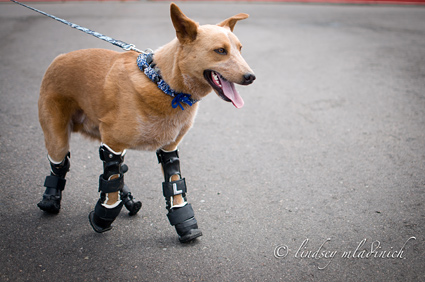High-Tech Prosthetics Give Exotic Animals and Everyday Pets a New Lease on Life
Published on September 23, 2011

The new movie Dolphin Tale is inspired by the real-life story of Winter, a bottlenose dolphin who lost her tail after it was injured in a crab trap near Cape Canaveral, Fla.
Winter learned to swim again, but her body compensated with a side-to-side motion, which threatened her spine and internal organs. With the help of prosthetics specialist Kevin Carroll of Hanger Orthopedic Group and a team of veterinary and marine specialists, an artificial tail was created to allow Winter to swim without hurting hurself.
Though Winter’s story is getting the big Hollywood treatment, (read other Vetstreet stories about Winter here and here), other animals are also benefiting from high-tech prosthetics.
Helping Dogs Walk
Denver-based OrthoPets manufactures devices for about 165 animals per month, with dogs accounting for 95 percent of patients.
“The goal is to get pets back to an active lifestyle,” says Amy Kaufmann, who founded OrthoPets with her husband, Martin, in 2003. And although the majority of the patients are dogs, Kaufmann stresses that each device is custom designed to best suit the individual animal. The company works with local veterinarians to ensure that each device fits perfectly. Environmental factors are also taken into consideration.

“A pet who lives in New York City needs a different type of prosthesis than a dog who lives near the beach,” she says. Prostheses that take the place of missing limbs give extra confidence to three-legged animals, which is particularly important as they age and the remaining legs weaken. While a three-legged dog can get along well for many years, Kaufmann says that a four-legged dog does better.
Prosthetics are also saving the lives of animals who, in the past, would likely have been euthanized. “Nothing is off the table,” Kaufmann says.
One of OrthoPets’ more remarkable cases involves a dog named Nakio, who was fitted with four prosthetic paws. Nakio was just 5 weeks old when he was found in an abandoned foreclosed home with his paws stuck in an icy puddle. He had barely survived the Nebraska cold, and all four of his feet grew into rounded stumps. Thanks to prosthetic paws, Nakio now can run, jump and play just like other dogs. Like most prosthetic devices, Nakio’s are “socket prosthetics,” that is, the stump of the limb goes inside the prosthesis, and straps and other attachments hold the device in place.
“As long as the device is expertly manufactured and fits properly, most pets adjust to the prosthesis quickly and do very well,” says Dr. Denis Marcellin-Little, an orthopedics professor at North Carolina State University College of Veterinary Medicine. But Marcellin-Little is helping create other, potentially permanent options.
The Cutting Edge
Marcellin-Little is at the forefront of what many consider the future of animal prosthetics. He has pioneered a procedure called osseointegration. Osseointergration involves fusing the prosthesis to the bone. The artificial limb then remains fixed in place as opposed to being removed each night as with traditional prostheses.

In March, Marcellin-Little successfully performed the state-of-the-art procedure on a 5-year-old Siberian Husky named Zeus, who lost his front paw when another dog mauled him as a puppy. It was the first time osseointegration was performed on a front limb. The professor hopes that the continued success of osseointegration will lead to its use in larger animals such as horses, who are typically euthanized when limbs are damaged. He says that, ultimately, veterinarians may be viewed as trailblazers for the introduction of osseointegration for human amputees.
In the image above, Zeus is wearing his “training foot,” which helps him get ready for the final prosthetic. According to Marcellin-Little, “The training foot is a relatively simple foot that is placed so that a dog can walk. The final foot is more sophisticated. It may have a better energy return (bounce), be light, wear resistant, have a fine-tuned length, an ergonomic shape, and features that would protect the bone-implant interface if excessive stress is placed on it (called mechanical fuses). We are doing research on this topic at this time.”
“We see the possible benefits for humans — implants that allow the prosthetic limbs to attach without chafing and limbs with a more natural range of motion,” he says. “The implications for this procedure are huge.”




